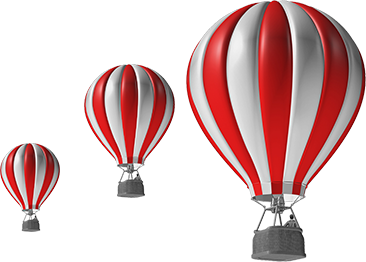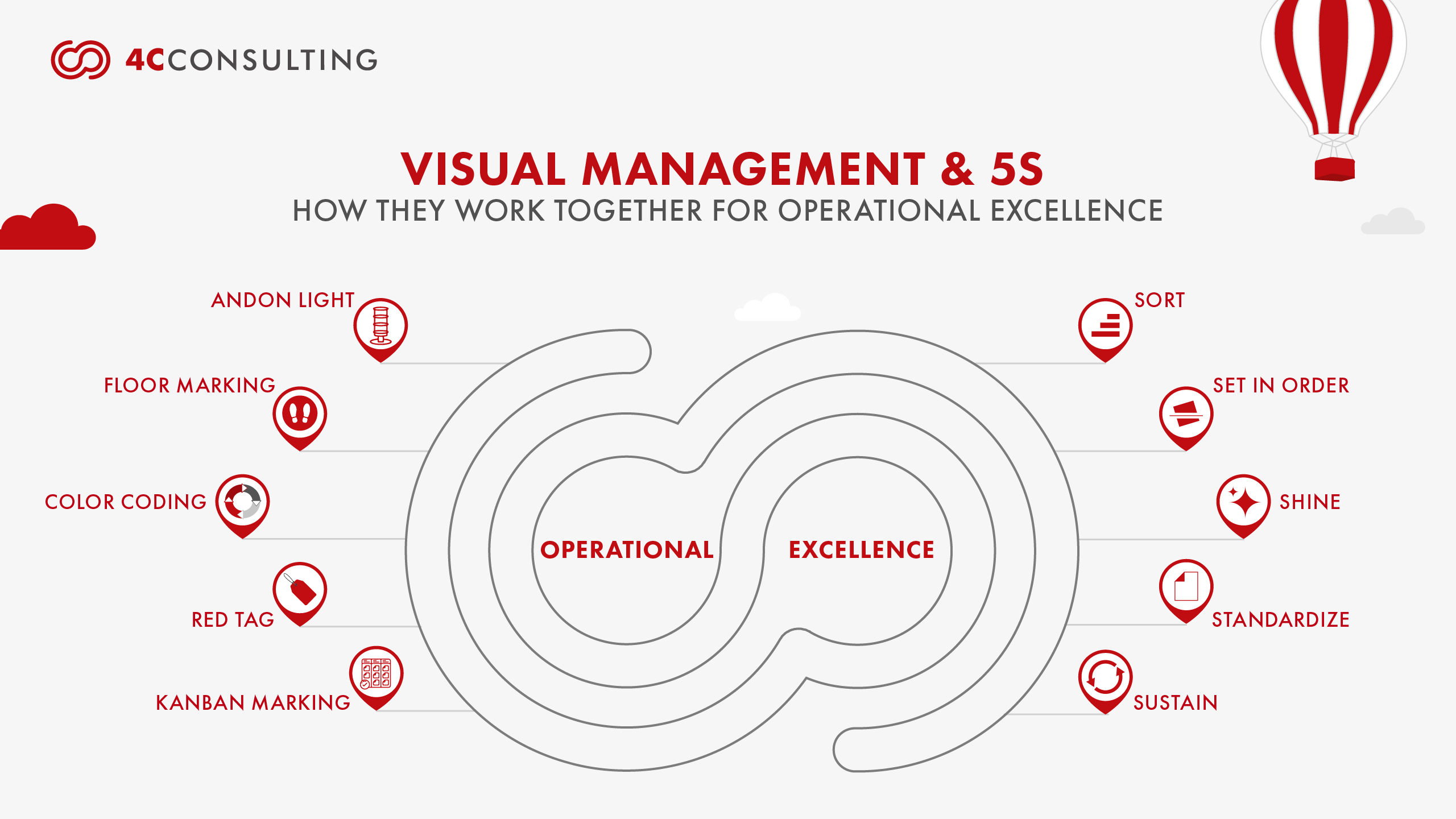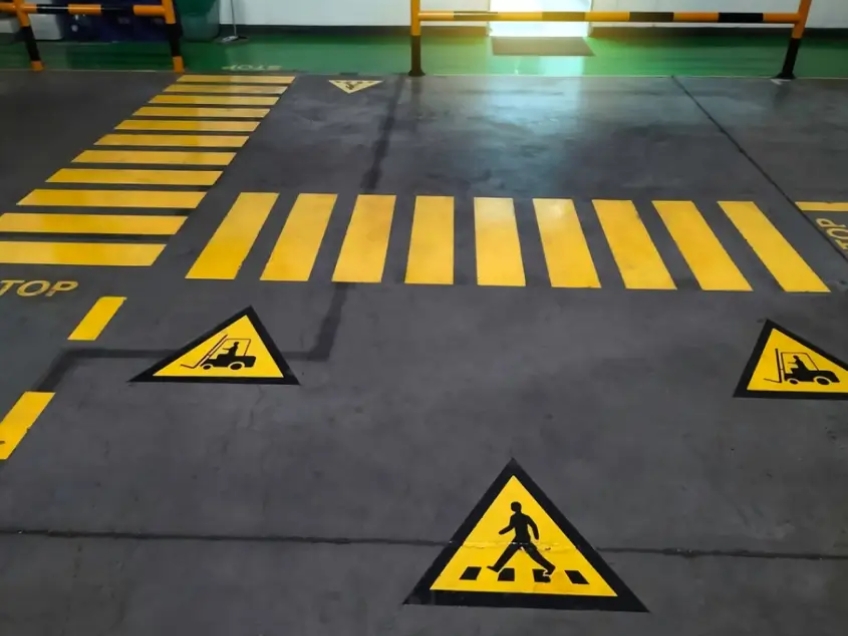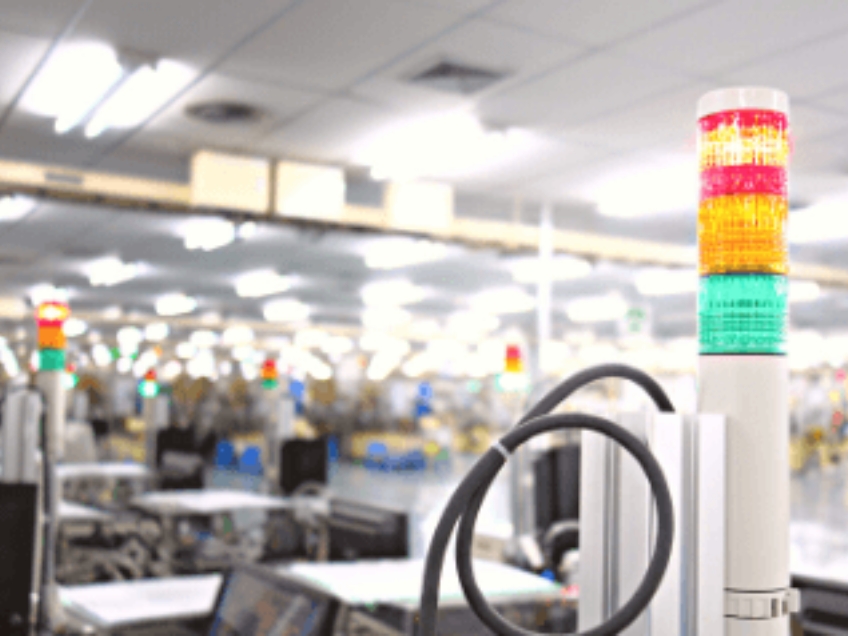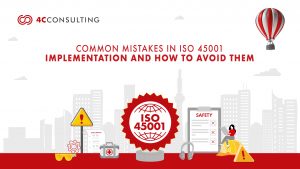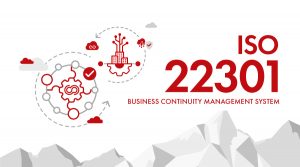VISUAL MANAGEMENT AND 5S: HOW THEY WORK TOGETHER FOR OPERATIONAL EXCELLENCE
21st Jun, 2025Modern safety-focused industries operate at a fast pace where disorganization creates substantial financial costs. Studies confirm that 20% of productivity decreases because of clutter alongside 40% increased errors resulting from poor visibility of tasks and standards. Organizations that implement a 5S structure combined with visual management clarity experience waste reduction while developing a culture that promotes accountability and safety alongside continuous improvement.
This guide explains the combined operation of these two methods to establish intelligent workplace safety systems. It will give you immediate possibilities of applying all these methods with real-world examples in addition to the working tools and step-by-step information.
WHAT IS THE 5S METHODOLOGY?
The framework application of 5S systems originated in Japan as a formal system to ensure workplace organization, discipline, and efficiency at work. Based on the Kaizen philosophy of “Continuous Improvement”, 5S is a five-step process divided into sequences, which are as follows: Sort, Set in order, Shine, Standardize, and Sustain. Collectively, these actions will result in waste elimination, enhanced safety, and a culture of visual control and team accountability.
.
Drive Operational Excellence with 5S & Visual Management.
The illustration of a real-life situation of workings of the 5S steps of an industry by taking an example of a precision components manufacturing unit is as follows:
- Sort (Seiri): The first phase entailed the systematic sorting out and eliminating items that were not required in the shop floor not to mention the out-dated materials, duplication of tools and machines which had ceased being utilized. Red tags were placed on items that had not been used during the last three months and they were relocated or discarded. This made the working environment cleaner, safer and did away with the hindrances that would hinder efficiency in the past.
- Set in Order (Seiton): Since there are few materials left, the staff arranged working places with shadow boards on tools, labelled areas on consumables, and identified zones by colour on raw materials and finished good. This organized outline saved time during the search, increased the scope of the working process visibility, and better ergonomics in the working spaces.
- Shine (Seiso): The practice of regular cleans was adopted, coupled with the elaborate checklists of the machinery, floors, and equipment departments. On one such check, minor wear was noticed in a lathe belt and its repair was carried out before the belt broke and caused an expensive repair of an expensive machine.
- Standardize (Seiketsu): The team worked by creating and using visual standard operating procedures (SOPs), color-coded labels systems, and 5S audit sheets to make things consistent. Such factors were used in all shifts, and thus all the staff members could use the same guidelines on how the tools should be placed, how often they are checked and the way, they are stored.
- Sustain (Shitsuke): There were weekly audits and training sessions which reinforced the newly put to place practices. To keep the compliance in check, a special board related to the 5S performance was established to display improvement tasks, as well as stimulate participation on a continuous basis. Eventually, the employees started taking initiatives to uphold the standards making 5S part of the organizational culture as a usual operation discipline.
WHAT IS VISUAL MANAGEMENT?
Visual management core Lean tool employs visual cues, signs, colour coding, symbols, charts, and display boards as a way of passing important information in a time-effective and understandable way. Its aim is nothing fancy, but strong enough, to make operations transparent to the point where there is no need to ask about the status of work, expectations, and possible problems at a glance by any single member of the team.
Visual management makes team actions effective, and immediate, and it helps cut errors and keeps the working environment safe, effective, and self-monitored, as opposed to following verbal instructions or extensive documentation.
.
Core Visual Management Tools (with Practical Use Cases):
- Color-Coded Labels and Zones:

Labels on bins, racks, and drawers can help the users differentiate material types (e.g., raw and finished goods and good and reject parts can be differentiated with color-coded labels). Green and red tape used at one of the facilities when used initially within the first month of operation resulted in the following a reduction in line mix-ups.
.
- Floor marking and Walkways:

Walkways, storage areas, hazard areas, and equipment parking are marked out by floor lines taped or painted. This minimizes confusion in traffic and enhances safety. The organization has reduced pedestrian-forklift collisions after enforcing a unique yellow walking ground in its logistics centre.
.
- Visual Task/Kanban Boards:

This system involves Kanban, which uses columns headed to be completed, being done, and in progress and cards to review the progress of the tasks. The teams who use such boards can have better collaboration with a decreased number of missed deadlines and quicker prioritization of the tasks especially when they have regular stand-up meetings.
.

Andon systems offer immediate visual indication of an occurrence of the problem. In case a machine is broken or a quality check did not pass the result is indicated by a red or amber colour. Amber lights were set off at least two seconds in advance at a metal fabrication plant so that supervisors could step in before scrapping happened.
.

They are the main means of displaying data in real-time by using mounted display screens. The dashboards allow the teams to adjust their operations in real time and the managers can utilize them in avoiding problems in operations. The on-time delivery elevated with the help of assembly line real-time dashboards.
The visual tools operate at their best because our brains understand images and colours faster than written text. When employees can see tool placements along with task status and safety zones visually without requiring verbal directions they learn faster while making fewer mistakes. Most organizations experience new hires achieving complete productivity within their first shift because the workspace provides visual clarity and an action-oriented structure.
.
HOW 5S AND VISUAL MANAGEMENT WORK TOGETHER?
The workplace gains order through 5S as its base while visual management demonstrates this order through its visible elements. The combined implementation of these systems creates an environment that operates independently through easy management and natural order.
| 5S Step | 5S VISUAL MANAGEMENT EXAMPLES | HOW IT HELPS |
| Sort | Red-tagging unneeded items | Identifies what’s unnecessary and initiates removal |
| Set in Order | Shadow boards, shelf labels | Ensures everything is stored visibly and accessibly |
| Shine | Cleaning checklists, inspection charts | Keeps cleanliness measurable and consistent |
| Standardize | SOP posters, 5S audit boards | Reinforces uniform procedures and visual standards |
| Sustain | Visual trackers, audit dashboards | Builds accountability and helps monitor compliance |
The visual tools provide assistance for every stage of the 5S methodology:
The teams are not guessing their next step because there is visual reinforcement throughout each phase of 5S. The team is able to function independently under self-management, which eliminates waste, halts errors, and organizes space without constant supervision.
.
INTEGRATING 5S AND VISUAL MANAGEMENT FOR TRUE OPERATIONAL EXCELLENCE
The introduction of 5S and visual management programs as individual projects may have certain benefits, however, the integration of the two accompanied by the right strategic planning will create a system that will transform the structure of everyday behaviour in the workplace, align the teams and incorporate the spirit of operation excellence into the bloodstream of your company.
The integration is not just a labelling tool or a floor cleaning mechanism; there is much more to it than that; it is a matter of teamwork, communication, and how they can solve problems in a visual and orderly way. This is how organizations can effectively merge the two systems into their formation of long-term performance and cultural impact:
- Compliance to Behaviour-Driven Systems: Rather than treat 5S and visual tools as an auditing requirement, present them as providing the capability of team decision-making. Include visual workflows into the very way daily work is done, and not only its appearance. To illustrate, cleaning is not meant to be done to be inspected but to aid in the discovery of process problems or near-miss.
- Bring Teams into a Common Visual Language: Visual controls, such as Kanban boards, Andon alerts, or red-tag areas and SOP displays, should be standardized across shifts and teams. This common visual language helps to avoid confusing situations, make the process of shift handover more effective, and minimize mistakes that are caused by the variety of interpretations of the questions, relating to the way, things should be performed.
- Relate Business Data to Business Objectives: Tie your 5S artwork and re-boards to actual business goals such as decreasing the downtime improving OTD or improving first pass yield. The more performance indicators are pushed up by employee ownership of such measures as keeping areas clean and visual boards up to date, the more employees will likely accept ownership.
- Build 5s and visual management as a foundation: 5S establishes the foundation of order, cleanliness, and standardization. Visual management stimulates that base by enhancing behaviour that is operating in real-time. A well-sorted (5S) workstation at which no cycle time or quality status are shown, nor safety alert points, will not create a continuous improvement.
- Embrace the Visibility to Real-Time Ownership: Having visual trackers of goals, problems, and advancement on all workplace stations, accountability shifts not only to supervisors but to the workforce, in general. Operational excellence starts when the people on the team start to recognize problems, update boards, and keep standards up to date without specific instructions – that is where operational excellence gets its beginning.
- Establish a See and Solve Culture: Visual management provides the teams with a means to observe problems, and teams have the space, thanks to 5S, to be able to see problems. Collectively, they instil a can-do attitude among staff members who will constantly seek ways of enhancing layout, work process, safety, and output. This see-and-solve loop is at the heart of Lean excellence.
- Turn Integration a Competitive Edge: Those organizations that really have a combination of 5S and visual management cease to be reactive but become proactive and self-managed. This is not all about waste reduction; it is about creating a workplace where quality teams are fully engaged, mandating it to be consistent, and making changes faster and with less push-down required.
Together, 5S and visual management do not only clean the floor but organize the manner in which people think, behave, and interact with their work. That is how operational excellence will not be a
Want to begin your journey? Read our Step-by-Step Guide to Implementing 5S Methodology in Your Organization to get started the right way.
.
BENEFITS OF IMPLEMENTING 5S AND VISUAL MANAGEMENT:
The successful implementation of 5S and visual management creates benefits that surpass basic workplace organization and accelerated audit performance. These systems transform workplace culture while improving team performance and creating sustainable long-term excellence. Organizations that transition from basic surface implementations to genuine lasting implementation will discover the following benefits:
- Sustainable Process Control: Daily work routines which include visual elements enable teams to immediately detect deviations for prompt resolution. The clear definition of tasks along with tools and safety checks allows processes to continue smoothly without needing constant supervision. The system operates independently to safeguard standards from drifting away.
- Cross-Shift Consistency: Standardized visual elements and layout cues ensure that every shift operates according to the same rules and expectations regardless of floor staff. Standardized visuals prevent handover variability which leads to smoother operations and decreased rework caused by team practice inconsistencies.
- Greater Accountability & Engagement: The process of building and maintaining visuals enables employees to take full responsibility for their workspaces. A clean, labelled area reflects their effort and pride. Through visual management, each zone becomes a shared responsibility which naturally sustains team discipline and order.
- Faster Problem Solving: Real-time dashboards status boards and color-coded alerts enable teams to detect and fix problems instantly. Visual displays help teams spot issues promptly so they take action faster compared to waiting for supervisors or audits which results in decreased downtime accelerated solutions and better decision-making.
- Audit & Compliance Readiness: The combination of updated boards with SOPs and tracking systems facilitates faster internal reviews and external audits. Visual controls help organizations showcase compliance standards while minimizing documentation mistakes which improves their readiness for ISO EHS and customer-based certification requirements.
- Improved Safety & Reduced Waste: Visual clarity enables organizations to identify accident-prone locations and display unsafe conditions while tracking down lost tools. The combination of organized tools together with clean walkways and color-coded zones helps decrease unneeded movement while reducing risk and minimizing process waste throughout the system.
- Culture of Continuous Improvement: Visual boards undergo changes because team members submit their input. The process of soliciting employee suggestions about improving flow, layout, and visibility leads to continuous improvement becoming a regular topic of discussion. The Kaizen-driven environment guarantees the system evolves beyond basic survival to achieve thriving success.
.
The structured discipline of the 5S approach, coupled with the power of visual management thinking and visual clarity, can ensure the creation of a work environment that is safe, effective, and sustainable. Keeping lean working, wastes are removed, communication is promoted, and teams are granted authority over certain work processes.
Regardless of the context of manufacturing, healthcare, logistics, office settings, or any other situation – the synergistic impact of 5S and visual management supports the culture of continuous improvement and operational excellence. Organizations will have moved into the realm of competitive advantage if they go forth in implementing these practices to solidify their systems and performance; it is not just a tool but a framework that nurtures change.
.
HOW 4C HELP THE ORGANIZTAION IMPLEMENT 5S?
We, at 4C Consulting, assist organizations in implementing the 5S method with a structured, result-oriented approach that ensures long-term transformation of the workplace. Our certified professionals provide comprehensive assistance ranging from 5S training and internal auditing to documentation, visual systems, and certification. With on-the-ground experience across various industries and relied upon by industry leaders such as Arvind Textiles, Olam, Omax Cotspin, Adani Transmission, and Petrotec, we design every 5S implementation strategy to suit sector requirements. We help organizations implement 5S from scratch and increase their existing 5S practices while maintaining complete alignment with business objectives and minimizing waste. If you require help with 5S audits, training, or implementation, contact 4C Consulting today to receive expert guidance which will be customized for your workspace and operational goals.

Frequently Asked Questions:
The 5S operational framework consists of five structured stages that optimize both workplace organization and operational effectiveness. The five steps include Sort, Set in Order, Shine, Standardize, and Sustain. The operational teams gain advantages from these steps because they minimize waste while optimizing workflow efficiency and developing discipline and accountability.
The Japanese language provides the original 5S methodology with Seiri (Sort), Seiton (Set in Order), Seiso (Shine), Seiketsu (Standardize), and Shitsuke (Sustain) being its five components. The workplace organization and operational discipline depend on each step which fulfils an essential function.
Industrial operations use the 5S methodology which consists of these five phases:
1S – Sort: Remove unnecessary items
2S – Set in Order: Arrange tools for efficiency
3S – Shine: Clean and inspect regularly
4S – Standardize: Establish routines and visuals
5S – Sustain: Maintain the system through training and audits
The core operational excellence framework relies on 5S to establish consistent safety practices and performance standards. The system makes every process visible while making it repeatable and self-improving which forms the essential components of a lean operation that performs at its best.
The 5S steps form an integral part of Kaizen (continuous improvement). The foundation for daily small-scale improvements in Kaizen depends on 5S implementation. Teams can identify inefficiencies and implement changes more efficiently through a standardized and clean environment created by this system.
The 5S system in a company function as a Lean workplace organization approach that enhances productivity while minimizing waste and increasing employee responsibility. Companies apply 5S to develop orderly physical areas through visual management which supports their ISO requirements safety standards and quality compliance protocols.
System operational excellence represents an organization's capability to produce consistent value through systems that are properly designed efficient and sustainable. An organization achieves this by reducing waste while optimizing output alongside employee empowerment and continuous improvement practices.


